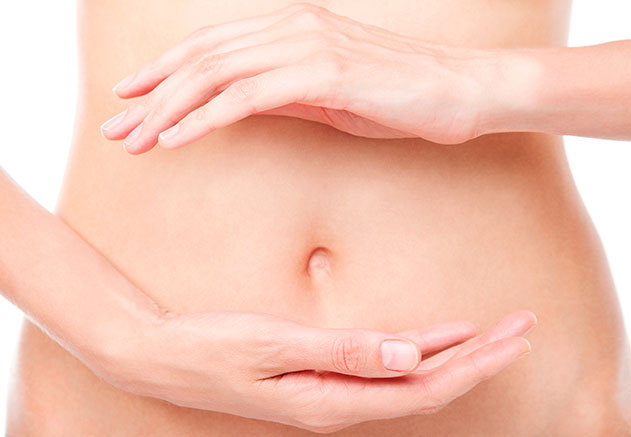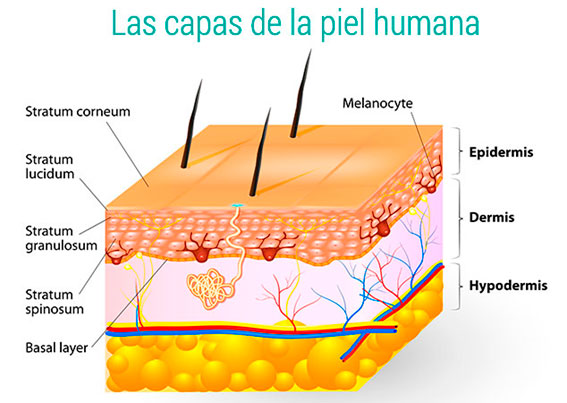The skin is the coating that covers the entire body surface and the largest organ of the body, with an approximate area of 2m2 (depending on the height and weight of the person).
Our skin has three distinct layers, from outside to inside:
- Epidermis
- Dermis
- Hypodermis or subcutaneous tissue
It also has other structures such as hair, nails, sebaceous glands and sweat glands.
It is the outermost skin layer; which in turn is formed by various layers. It acts as a protective barrier of the body against external agents.
The epidermis is covered by the hydrolipic layer, which is a mixture of sebum and sweat.
Through the different skin pores, two substances reach the skin surface, the sebum produced by the sebaceous glands, and sweat secreted by sweat glands. When they reach the surface of the skin, both secretions are mixed into an emulsion which is known as the hydrolipic layer indispensable to maintain an optimum skin hydration degree and which gives the soft look and texture to our skin.
The hydrolipic functions are to hydrate the skin and set the barrier which prevents the penetration of contamination due to its antifungal and bacteriostatic properties; This is due to acid pH (4.5 to 5.9). It also constitutes a barrier against ultraviolet radiation from the sun, thus delaying the aging of actinic origin.
It provides strength and elasticity to the skin, the support structure being the same, nourishing from inside the outermost layers of the skin and protecting it from external damages. It houses most of the touch receptors.
As years go by, the natural production of elastin and collagen decreases, consequently decreasing the skin’s ability to retain water, wrinkles appear.
External agents such as sun effects accelerate this process.
It is also known as subcutis.
It serves to storing energy, in addition to thermal insulation and mechanical protection against hits.
General functions of the skin
The different components of the skin perform the following functions:
- It represents a protective barrier against the invasión of microorganisms and against the action pf mechanical, chemical, thermal and osmotic agents.
The stratum corneum of the epidermis and its acid mantle form a barrier against bacteria and fungi and adipose cells of the hypodermis isolate the body from the cold and the heat, at the same time providing a cushion that acts as shock absorbent. It also has power of regeneration thanks to the cells of the dermis, being able to heal wounds. - It regulates body temperature through perspiration, dilation and contraction of the blood vessels and the adaptation of the hair (goosebumps and bristled hair).
- It assists in maintaining the water balance: Contains natural moisturizing factors (NMF), from the sebaceous oils of the stratum corneum, including the lactic acid and the urea that are attached to the water and help maintain the elasticity, firmness and flexibility of the skin.
- It has a pigment, the melanin, which is responsible for giving color to the epidermis and protection from the ultraviolet radiation, to the underlying tissues.
- Through the profuse innervation of the dermis, the organism captures feelings of touch, heat, cold, pressure, pain, allowing, thus, to interact with the environment and relate it to the central nervous system.
- Through the lymphatics and blood dermic vessels, substances are absorbed and pass through the epidermis, as some medications (lotions, creams or ointments).
- By the action of the ultraviolet radiation in the dermis the vitamin D is synthesized, important in the metabolism of the calcium.
- Certain integral cells of the epidermis (of Langerhans) and lymphocytes that arrive to it, they have the ability to capture antigens and transfer them to effector cells of the immune response, therefore the skin is considered as an organ of the immune system.
- Phsycological, social and aesthetic function: a healthy skin facilitates social life and relationship of the individual to its environment and enhances its self-esteem.
Skin’s pH
The most important function of the skin is being the barrier or protection against external agents.
Precisely, the acid mantle of the skin (part of the hydrolipic barrier) protects us thanks to the acidity of the medium, unfavourable for microorganisms.
The pH is an acidity value and it is measured on a scale of 0 to 14.
From 1 to 7 is in the acid scale, with 7 being neutral pH corresponding to pure water and from 7 to 14 corresponds to basic or alkaline pH. The acid mantle pH of the skin is between 4.5 and 5.9.
The pH bulk of our body’s skin is at 5.5, although there are slight variations from one area to another and according to gender, being slightly more acid in men than in women.

Depending on the age, pH values from birth to puberty are more alkaline than in the rest of life. There is a sharp increase in acidity from puberty and then, a slight alkalinity tendency in the older years. There are no pH differences by race or skin colour.
The pH is slightly more alkaline in the armpit folds, inguinal and interdigital areas; and this is why they are most vulnerable to external factors.
In general, the vaginal pH is between 4 and 5, although it varies depending on the woman’s age and is linked to the hormonal changes experienced throughout her life and menstrual cycle. In girls up to puberty and women who are going through menopause, the vaginal pH is around 7.
If the pH values go up to basic values, the skin balance is altered, the skin loses water and it dehydrates since is unable to synthesize the essential epidermal lipids and barrier function is impaired. When the surface pH is more alkaline, dermatitis and pruritus of nonspecific character occurs. Any change in pH that it is not immediately compensated stimulates the skin to produce more acid to restore balance -buffer system- The neutralizing capacity will depend on the ability of the deeper layers to send acids to the surface.
Factors affecting skin pH
The skin’s pH can be altered by:
1. Intrinsic organism factors
As previously mentioned, age, the part of the body, genetic factors and the individual’s gender associated with hormonal changes, lead to changes in the pH of our skin.
2. External factors
There are external factors that damage our skin or worsen its condition and appearance:
- Very frequent washes with very hot water
- Changes in temperature and humidity
- Exposure to chemicals
- Inadequate or basic pH Cosmetics
- Pollution and environmental contamination
- Smoking, alcohol and drugs
- Excessive exposure to the sun or UV rays
- Inadequate nutrition
- Lack of sleep
- Stress
- Lack of exercise
- Certain diseases
- Certain medications and medical treatments

A healthy lifestyle and using the appropriate hygiene products and body care for each area of the body, will help maintaining the natural pH of the skin in order to retain its full protective function, which will provide a healthy look.
Skin Types
- Soft Skin
It is found on the eyelids and genitals
- Thick Skin
It is located on the lips, palms and soles of the feet. With a highly developed stratum corneum and a more yellowy tone due to its high keratin content
- Thin Skin
Mainly on women and covered body parts. With a thin stratum corneum, uniform surface and inconspicuous pores
The skin on the back of the hands is especially thin
- Toned Skin
It is tense and flexible
- Flaccid Skin
It is the one which has lost its elasticity and resilience after being subjected to deformation. Flaccidity increases with age and it occurs after sudden slimming.
- Oily Skin
It shows greater activity of the sebaceous glands
- Dry Skin
Due to a decrease in its water content prevents its barrier function.
- Normal Skin
It has a balanced hydrolipidic layer with the necessary levels of water and lipids
- Sensitive Skin
It has a skin tolerance threshold below normal skin, suffering uncomfortable sensations such as heat, tightness, redness and it is a fragile skin type.


